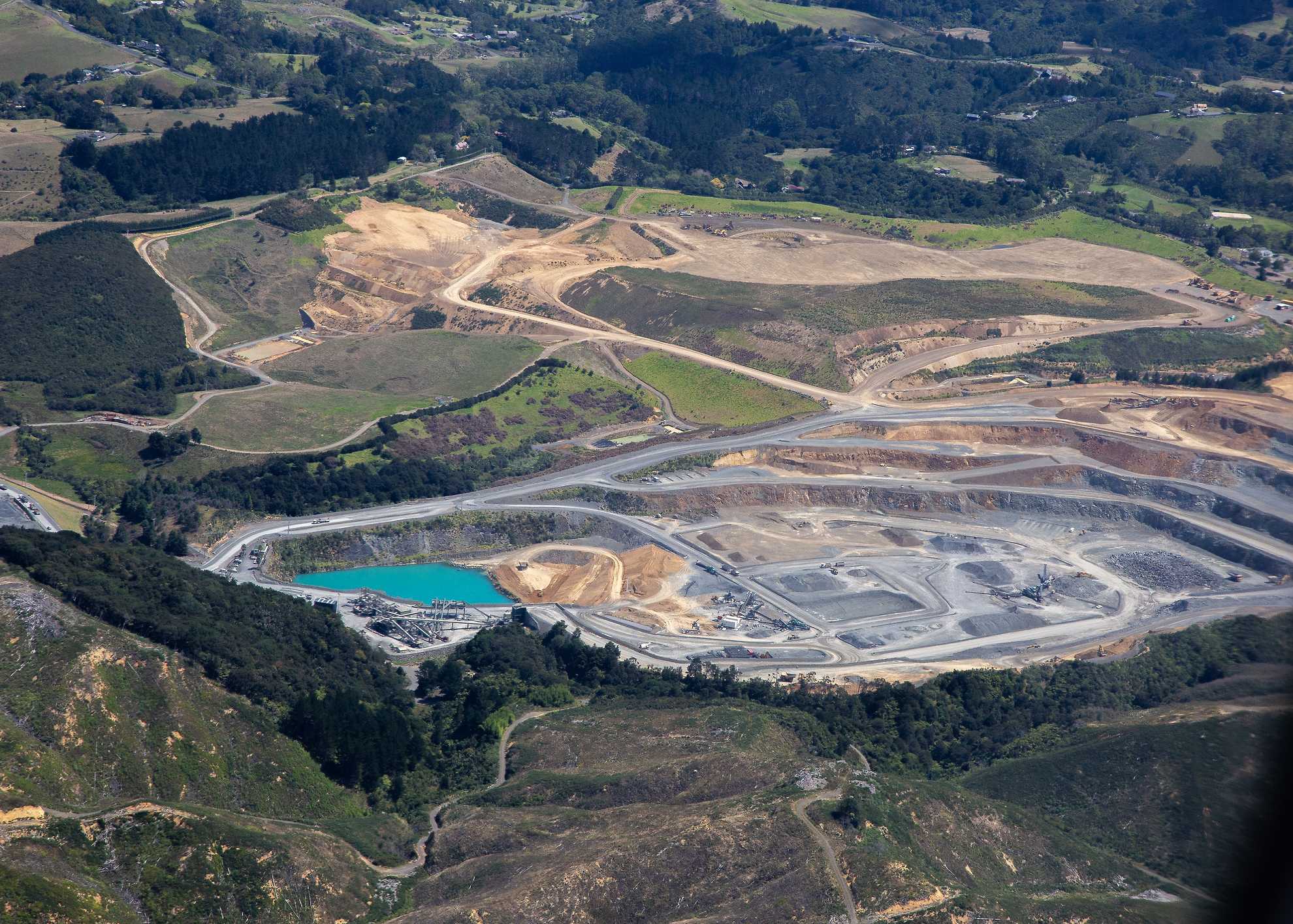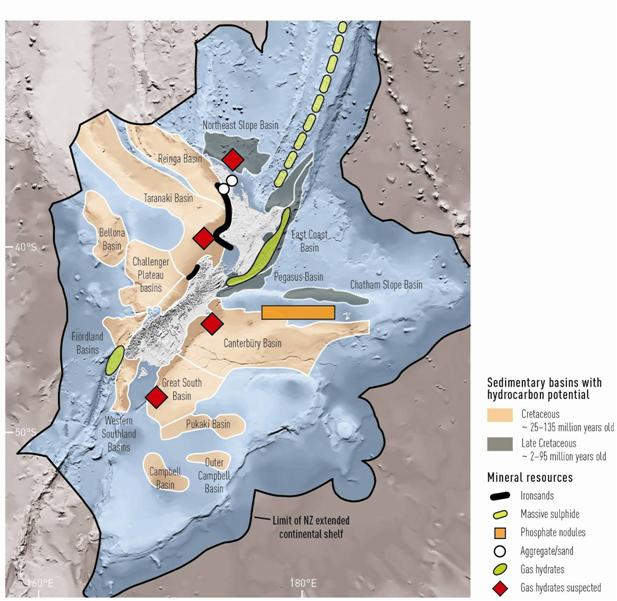Minerals
The minerals industry plays an important part in the New Zealand economy contributing jobs, infrastructure royalties and GDP. bf4999d2-bed5-4a14-8501-5c89a1782911
New Zealand has a number of mineral resources, including gold, silver, ironsands, phosphate and limestone. Rock, sand and aggregate resources are also mined for construction uses.
Gold rushes occurred in the Otago, the West Coast and Coromandel regions in the 1860s. The easily accessible resources, able to be worked by individuals using simple equipment, were quickly exhausted and larger-scale mining techniques were adopted. Despite this, production of gold in New Zealand peaked in 1905. In the early 2000s, gold production in New Zealand predominately occurred at two large opencast mines at Waihi (Coromandel) and Macraes (Otago).
cc763517-1157-40c9-acee-e307e34d18b0

New Zealand has extensive coal and lignite resources, mainly in the Waikato, Taranaki, West Coast, Otago, and Southland regions. National in-ground resources of all coal exceed 15 billion tonnes. Around 80 per cent of the coal resource is lignite (low grade coal) which is found in Southland and Central Otago. 17aadcb7-90ff-425d-80ce-9f6e497e9136 Coal production in 2015 was 3.4 million tonnes. 282a92a4-4053-471f-89ae-9a78a3a5c2a4
New Zealand uses coal for domestic purposes such as electricity generation, hothouse horticulture, to heat large buildings such as universities, schools and hospitals and to process dairy, meat, wool and wood in the South Island. New Zealand also exports coal to countries such as India, China and Japan, exporting 1.4 million tonnes in 2015. 1e20a0f7-c268-49c6-974f-31c99e3795ab .
In 2010, the Parliamentary Commissioner for the Environment published a report on lignite and climate change
a681ebcd-ad21-475f-b6a2-efb62fabd65d
which was then updated in 2012.
9bc8f0e9-3a0e-4cbd-8ac3-1290f8919a26
Click Here to see a Map of NZ coal fields
The marine environment includes large areas of relatively shallow sea underlain by plateaus and tectonic ridges that border the deep ocean basins of the Pacific Ocean and Tasman Sea. 5d7fe6b8-90a5-4c6b-9017-0d23004d4b3e To the northeast there are volcanic arcs, including the Kermadec Arc.
The minerals that lie under the ocean have historically been considered too difficult to extract except in shallow waters. However, as resource prices rise and deep sea technology develops, the attention paid to these minerals has dramatically increased. The excavation of phosphate nodules, seafloor massive sulphides (SMS) and manganese nodules is expected to be of increasing commercial interest within the next few years. d5eacfe1-e8b8-4cbf-9045-f1cb22366c04

Marine Minerals
Mineral mining of New Zealand’s EEZ seabed is an emerging industry. Trans Tasman Resources Limited marine consent application was the first EEZ seabed mining application to be processed. This application was declined in June 2014. a74fe207-536c-4f07-8796-ff652c69ace8 Since that time there has been two further applications for marine consents for seabed mining within New Zealand’s EEZ. In June 2015 Chatham Rock Phosphate Limited (CRP) lodged a marine consent application for phosphate mining on the Chatham Rise, this application was also declined. dba17462-9fec-49a3-899f-5704729660f4 In 2016 Trans Tasman Resources Limited (TTRL) reapplied for marine consent to mine iron ore in the South Taranaki Bight. The 2016 application of TTRL was the first seabed mining application in New Zealand to be approved under the EEZ Act in 2017. 675d1985-7421-41a7-a65a-722da4abcf4c The decision was split and is under appeal on points of law. A hearing is due in April 2018.
The following table provides detail about the main mineral resources found within New Zealand's EEZ.
Mineral | Detal |
|---|---|
| Phosphate nodules |
|
| Seafloor massive sulphides |
|
| Manganese nodules and cobalt crusts |
|
| Methane hydrates |
|
| Sand (including ironsand) |
|
-
http://www.nzpam.govt.nz/cms/investors/our-resource-potential/minerals/coal
-
http://www.teara.govt.nz/en/mining-and-underground-resources/page-2
-
http://www.nzpam.govt.nz/cms/investors/our-resource-potential/minerals/coal
-
http://www.gns.cri.nz/Home/Our-Science/Energy-Resources/Oil-and-Gas/NZs-Sedimentary-Basins
-
http://worldoceanreview.com/en/wor-1/energy/marine-minerals/
-
Ministry for the Environment, 2012, Managing our oceans: A discussion document on the regulations proposed under the Exclusive Economic Zone and Continental Shelf (Environmental Effects) Bill, Ministry for the Environment, Wellington
-
NIWA, 2012, Expert risk assessment of activities in the New Zealand exclusive economic zone and extended continental shelf , Prepared for the Ministry for the Environment, National Institute of Water & Atmospheric Research Ltd, Wellington
-
Ministry for the Environment, 2012
-
NIWA, 2012, Expert risk assessment of activities in the New Zealand exclusive economic zone and extended continental shelf , Prepared for the Ministry for the Environment, National Institute of Water & Atmospheric Research Ltd, Wellington
-
http://worldoceanreview.com/en/wor-1/energy/marine-minerals/
-
http://www.straterra.co.nz/21st%20century%20mining
-
NIWA, 2012, Expert risk assessment of activities in the New Zealand exclusive economic zone and extended continental shelf , Prepared for the Ministry for the Environment, National Institute of Water & Atmospheric Research Ltd, Wellington
-
http://www.straterra.co.nz/21st%20century%20mining
-
http://www.gns.cri.nz/Home/Our-Science/Energy-Resources/Gas-Hydrates/Current-Research/Gas-hydrates-as-an-energy-resource
-
http://www.nzsteel.co.nz/new-zealand-steel/the-story-of-steel/the-mining-operations/waikato-north-head-mine-site/
-
http://www.teara.govt.nz/en/marine-minerals/page-2
-
http://www.solidenergy.co.nz/our-coal/solid-energys-coal/premium-export-coal/
-
http://www.mbie.govt.nz/info-services/sectors-industries/energy/energy-data-modelling/statistics/coal/?searchterm=coal%20production%2A
-
http://www.pce.parliament.nz/publications/update-report-lignite-and-climate-change-the-high-cost-of-low-grade-coal
-
http://www.pce.parliament.nz/media/1293/pce-lignite-update2.pdf
-
http://www.epa.govt.nz/EEZ/previous-activities/notified-consents/trans_tasman/decision/Pages/default.aspx
-
http://www.epa.govt.nz/EEZ/previous-activities/notified-consents/chatham_rock_phosphate/decision/Pages/CRP_decision.aspx
-
http://www.epa.govt.nz/EEZ/whats-going-on/current-applications/ttr-2016/Pages/The-decision.aspx
Last updated at 4:45PM on February 4, 2025